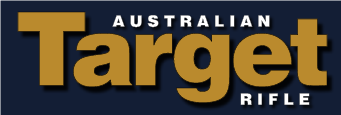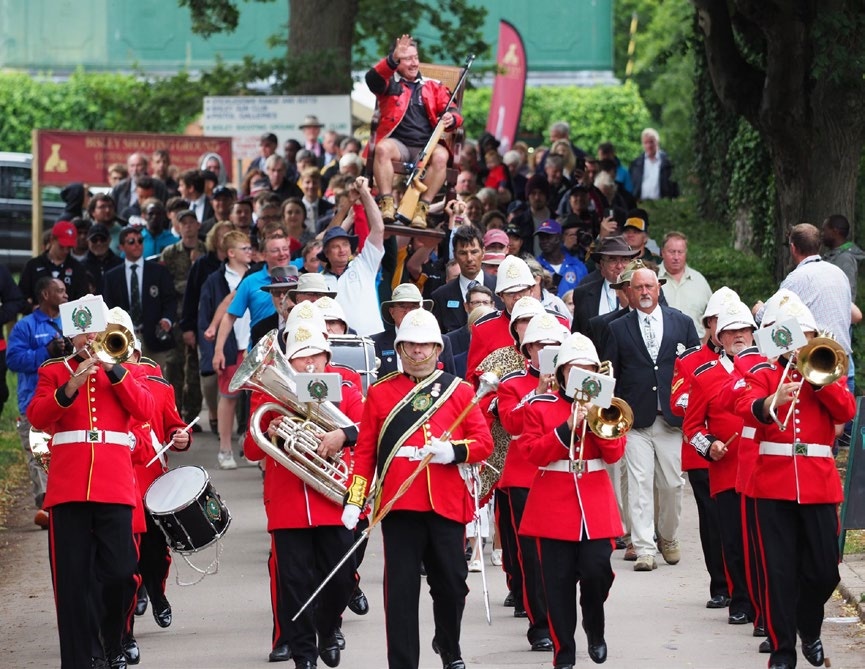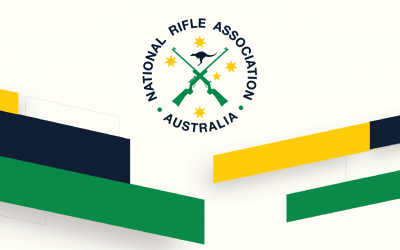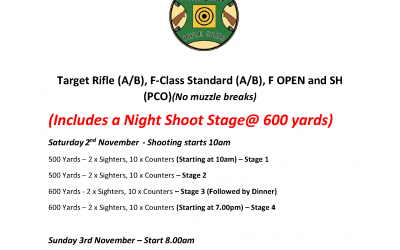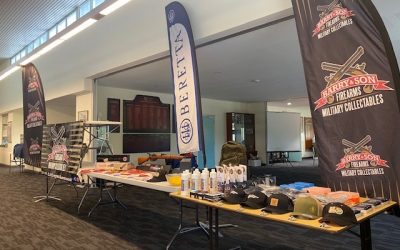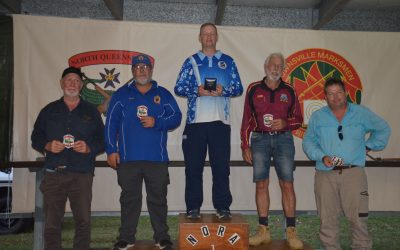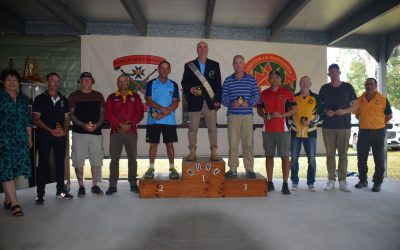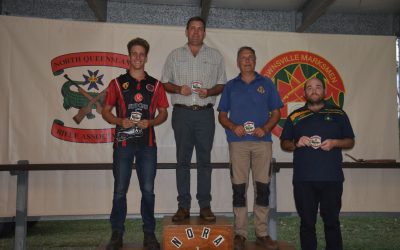
In 1860, Queen Victoria founded an annual prize for shooting competition amongst the rapidly growing Volunteer force in England. The Queen’s prize was 250 pounds, a considerable sum of money at the time that was enough to buy a small house in London.
Today, the Queen still provides the prize for the annual Queen’s shoot winner. It is the only sporting prize that comes from her own purse, and it is still 250 pounds. Of course, the prestige of winning the Queen’s prize is priceless.
Save for brief pauses during the world wars, the Queen’s Prize competition has been held continuously since 1860, firstly at Wimbledon Common and then moving to Bisley in 1890.
This year marked the 150th competition, and the NRAUK conducted a special imperial meeting befitting this momentous occasion. The America Match was an addition to an already busy Imperial Matches shooting schedule.
In mid-2018, nominations were called for a National Rifle Association of Australia endorsed (Blue Jacket) team to represent Australia at the matches. Neil Gibbins was selected as captain and Steve Negus as manager.
In July this year, a squad of 21 travelled to Bisley, the largest NRAA team to ever compete in this event.
Some members travelled early and competed in the British Commonwealth Rifle Club (BCRC) two-day prize meeting held the weekend before the Imperial. This is an excellent competition to acclimatise to Bisley conditions and to set zeros and elevations with the issued ammunition to be used in the Imperial meeting.
The remainder of the team arrived on the weekend of the July 13th ready for two weeks of top-level competition.
Some of the team members who compete in Bisley each year have permanent accommodation arrangements in caravans and clubhouses. The rest of the team were accommodated in Bunkabins, very comfortable portable two-bed cabins with ensuites.
All the Bunkabins were together and we were co-located with some of the New Zealand team. Dubbed ANZAC Cove, this was our home for two weeks.
The first official event was the team Meet and Greet on the Monday evening. Organised by Di and Barry Wood, this is a regular event every year. It is the first opportunity for the whole team to get together and, because of the nature of this NRAA team, there were no selection trials or practices in Australia before we travelled.
Monday and Tuesday comprised of zeroing and range practice. We won a friendly match against the Army Rifle Team. On Tuesday evening, there was a team match and overseas team reception hosted by the BCRC.
This was the first of many social functions the Australian team were invited to over the two weeks of the Imperial meeting. The Bisley social calendar can be as busy as the shooting calendar.
The sun does not set until after 9.30pm, and this year it was not uncommon on some evenings to still be shooting up to 8pm. Obviously, this changes meal and sleep patterns, and when coupled with jet lag, it is something first-time travellers to Bisley take time to adjust to.
The Imperial Matches are steeped in tradition. This includes the scheduling and naming of daily events. This year, the inclusion of the America Match on the second Thursday caused the first half of the program to be moved forward one day. This created the unusual situation of the Friday Aggregate being competed for on Thursday, and the weekend Aggregate comprising Sunday and Monday competitions. Confusing for the locals.
The Imperial Matches, the individual and team events, have always been fired with issued ammunition with triggers set at a minimum of 1.5kg. The full Imperial matches program lasts for almost a month and incorporates a wide range of shooting disciplines as well as Target Rifle. This year the Target Rifle program had almost 1000 competitors.
Obviously, this requires a significant amount of ammunition. Last year, the NRAUK had a problem with the accuracy of the ammunition. Studies post competition identified the cause to be related to the projectiles. This year, hopes were high for problem free ammunition, as it had been in previous years.
Unfortunately, this was not the case. Early on, we and others identified an issue where the ammunition was causing the extractors, primarily on Barnards but some other makes as well, to dislodge or break. The NRAUK worked hard to identify the cause and rectify affected rifles, however the problems did persist throughout the whole event.
Obviously, this was very disruptive to the shooters affected and did impact on their individual and team scores. Over the meeting we recorded three breakages and 22 dislodgements in the team.
Apart from this, the ammunition was generally very accurate and team members recorded good scores.

Five team members were successful in winning badges in the Queen’s hundred final – James Corbett (15), David Brewster (24), Angus Bell (43), Matt Pozzebon (50) and Steve Negus (67).
We also had six team members in the top 50 of the Grand Aggregate – Matt Pozzebon (sixth), David Brewster (12th), Mark Horsnell (17th), James Corbett (18th), Steve Negus (28th), Peter Maher (39th).
Riding the wave of the Australian Teams success at this year’s Palma Match, the expectations for this team were high.
We adopted many of the coaching lessons and disciplines that contributed to the Palma win. This was particularly important as there was a much wider variation of skill and equipment in this squad.
The coaching team was led by Steve Negus, multiple Australian team coach and experienced Bisley shooter as master coach. We used the Palma team skills and experience of Hamish Pollock and Matt Pozzebon and the Canberra, Australian Match Rifle Team and Bisley wind-reading experience of Shaun Wingrove as the coaching group.
This group worked well together in all the major teams matches and were supported by team members in plotting roles.

Where possible, we used the method of corrected wind and elevation plots used by the GB team. This has been proven to save points and is one of the reasons GB have been the top team at international level for many years.
This year with the addition of the America Match, there were four major teams matches we focussed on.
The first was the Overseas Match. This is usually ‘our’ match. We have been successful in previous years, and whilst this year there were more overseas teams than usual, we were confident of doing well. However, an incorrect elevation setting and a malfunctioning rifle robbed us of valuable points, and we had to settle for second behind Jersey with USA third.
Next was the America Match. A marathon event of eight shooters, 15 shots at 300, 600, 900 and 1000 yards.

The weather in Bisley had been good. There had only been rain on one day that caught some team members unfortunate to be shooting at the time. The forecast for the America Match day was hot, very hot. Being used to shooting in these conditions, we felt they may suit us.
We prepared well by having eskys with ice, wet towels and 150 bottles of chilled water on the mound ready for the coaches, shooters and supporters. It ended up being the hottest day ever recorded in England, over 38 degrees, and we drank all 150 bottles.
The team shot well under pressure, but local experience counted with the home teams taking the top positions. England first, Scotland second and Wales fourth. USA managed a credible third with Australia fifth and seven teams behind us.
Many of the shooters were physically spent, but we had to recover quickly because the next day was the Kolapore Match, the blue riband event of world short range team shooting.
It is like the Olympic 100-metre sprint final. Teams of eight firing one sighter only and 10 shots at 300, 500 and 600 yards. No margin for error. Must be out of the blocks fast.
Australia last won this event in 1985 with a record score at the time. Two of this team, Peter Maher and Neil Gibbins, were members of that winning team and we were hoping for a repeat.
The Kolapore Match is the only teams event at the Imperial matches in which Great Britain competes, they are on their home ground and select the best eight shooters from all the home nations – England, Scotland, Ireland and Wales combined.

Every GB shooter wants a Kolapore cap, they are extremely difficult to earn. Only the best shooters and coaches get to compete. The GB team has not been beaten in the Kolapore for nearly 30 years.
The extreme heat the day before had taken its toll on our shooters and we had to make two unexpected team changes on the morning of the match. However, we were confident we had good coaches and solid shooters fully capable of the scores we needed to win.
GB started strongly at 300 with a 397.54 out of 400. We were close behind on 395.40 with Canada two points further back. An OK start but work to do if we were to catch up.
And work we did. We won 500 with 398.47 to GB 396.51. With only 600 to go we were level on points, behind on centres.
Paul Deach, the NRAUK media person, and his colleague Alun Lewis, an ex-BBC announcer, were broadcasting live to the world from behind the Australians.
The crowd were with us, cheering on the Aussies to topple the mighty GB team.
The final range. We dug deep for a very solid 395.45, three 50s and five 49s in the team.
However, the big match experience in the GB team showed, and they fired four 50s and four 49s for a score of 396.43.
They had won by only one point and centres, 1189.148 to our 1188.132.
Disappointing to come so close, however there was enormous respect for the Australian team performance from all the competitors and supporters.
One of the great things about Bisley is that there is plenty of shooting. For example, on the last Friday, Kolapore day, there is also a Queens 2 and the Donaldson Memorial match. Shooters in the Kolapore Teams, Queens 2 and the Donaldson shoot seven times during the day. Pacing yourself and stamina is very important because all the big matches are at the end of a very full two weeks of shooting.
The final teams match, The Mackinnon, was on the morning of the next day, being Queen’s final day and the last day of shooting.
The Mackinnon is teams of 12 shooting 10 shots at 900 and 1000 yards. Twelve in the team was really going to test the depth of the squad at the challenging longs of the legendary Stickledown range.
England, shooting in their backyard, won with 1170.143. Scotland came second (1159.123), the USA third (1157.108) and Australia fourth (1152.124) with six teams further behind.
GB shooter Glynn Barnett top scored the match for England with a 50.10 and a 50.9. If that was not enough, Glynn continued in the afternoon to shoot a pair of 75s to win his third Bisley Queen’s. An unbelievable day of shooting.
After the traditional chairing of the winner accompanied by a full brass band, it was a quick change into No.1s for team photos and the presentation ceremony.
Bisley has the largest collection of trophies of any sport in the world, a priceless collection of historical silverware.
Many of the team members won trophies for individual events, however the best surprise was the team had won the Dominion Cup for the top international team at the competition.
Our consistent shooting in the Overseas, Kolapore and Mackinnon Matches had given us a combined score of 3544.378, which was 15 points and 31 centres in front of the USA on 3529.347 with six teams further back.
Fitting recognition for a good consistent team performance.
